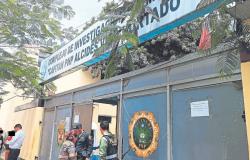Medicine scholar seeks to avoid pleural biopsies in cases of extrapulmonary tuberculosis
Nazarena Leiva Sanz, accessed a Scholarship to Stimulate Scientific Vocations (EVC-CIN) to investigate the possibility of diagnosing tuberculous pleural effusion, and correlating it with pleural biopsies in young patients from the city of Corrientes. Her work could change the approach to this condition in the region.
Extrapulmonary tuberculosis originates when the bacteria that causes it (Mycobacterium tuberculosis or Koch bacillus) affects other organs outside the lungs in which it resides: kidneys, lymph nodes, spine, joints, bones, etc.
Extrapulmonary Tuberculosis includes forms that are located partially or totally within the thorax such as hilar or mediastinal lymphadenopathy. Tuberculous pleural effusion (TBPE) is the most common form of extrapulmonary tuberculosis and is one of the most common causes of pleural effusion.
It is called a pleural effusion because the infection reaches the pleura, which is the thin layer of tissue that lines the lungs and the inner cavity of the chest wall.
To identify a DPTB, a pleural biopsy must be performed, because the infection does not manifest itself in sputum tests (as in tuberculosis) or in blood. But because biopsy is an invasive practice that can lead to complications such as pneumothorax, hemothorax, among others, other less risky identification tests have been explored, such as the Adenosine Deaminase (ADA) test.
Currently, international Guidelines such as the SEPAR Guidelines and the National Guidelines record that ADA is the main biomarker of DPTB with a capacity to detect the disease (global sensitivity) of 92% and a specificity of 90%.
This Adenosine Deaminase enzyme acts as a biomarker since it marks the presence of a physiological process (extrapulmonary tuberculosis) and therefore makes its diagnosis possible. The determination of ADA is recommended in clinical practice due to its low cost and rapid availability in routine biochemical analyses.
In this context, Nazarena Leiva Sanz, a student at the UNNE Faculty of Medicine, accessed a Scholarship to Stimulate Scientific Vocations (EVC-CIN) proposing to evaluate the need to diagnose tuberculous pleural effusion through an ADA test, avoiding performing Pleural biopsy in patients under 35 years of age in the city of Corrientes.
The work is under the direction of research professors from the UNNE Faculty of Medicine, Dr. Alfredo Ángel Aquino and Dr. Mirta Pedemonte.
What the fellow will try to demonstrate by comparing and verifying ADA test values is that pleural biopsies are not necessary.
“This work seeks to validate the effectiveness of the Adenosine Deaminase (ADA) biomarker in the diagnosis of Tuberculous Pleural Effusion (TPTB) and its application in endemic areas such as Corrientes, seeking to adapt international guidelines to our reality. There is a group of patients who must be biopsied for other causes. The survey will be carried out on these patients,” specified Dr. Aquino.
The patients who are selected for the study will have the characteristic of being under 35 years of age with a pleural ADA greater than 40 IU and from the city of Corrientes, as it is an area with a high number of cases. Thus, in these empirical cases, the correlation of national and international guides with current events in the region will be verified.
The cases will be selected adopting an intentional criterion from those pleural biopsies that tested positive for the diagnosis of DPTB, registered in the Central Laboratory of the City of Corrientes in the last 10 years to date.
The reason why the parameter of pleural ADA greater than 40IU is adopted is because in the international order, optimal levels of ADA have not been established to identify DPTB, but in areas of high prevalence such as Corrientes, pleural effusion with lymphocytic predominance associated with ADA greater than 40 IU has a positive predictive value of 98% and is considered sufficient to initiate antituberculous treatment without the need for a direct diagnosis through pleural biopsy or thoracoscopy.
Regarding the impact that the study may have, Dr. Aquino noted, “it will offer a deeper understanding of the usefulness of ADA determination in the context of suspected DPTB, which could influence clinical decisions and improve diagnostic accuracy.” ”.
On the other hand, the work will leave open the possibility of designing other lines of research that could include knowing the usefulness of ADA in other demographic groups or in contexts with different prevalences of tuberculosis and with patients over 35 years of age.
It could also focus on the practical implementation and evaluation of clinical protocols based on the findings of this study, which could improve the timely diagnosis and treatment of DPTB in endemic areas.






